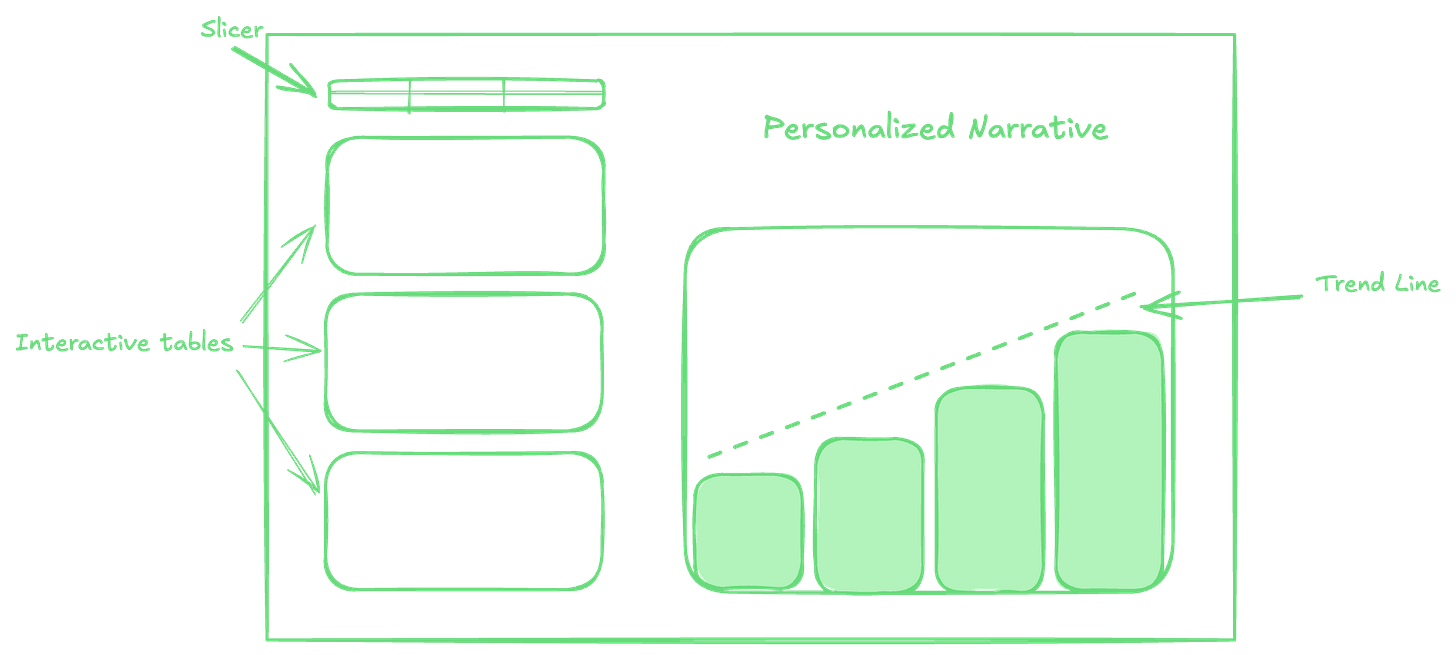Breaking into Product Management in 2024 and Beyond
How I made the seemingly impossible jump from Program to Product in one of the most volatile tech markets of the decade

I was laid off in February 2020 from my marketing role at a small AI startup, and it wasn’t the first time. I had worked for two other startups before; at both I was either laid off or survived a layoff (which was equally scaring). In 2020, I was living in LA, and barley had any savings due to the high cost of living. I immediately was thrown into a panic and started mass applying for roles.
Then in March 2020 as the world shut down and ushered in a new era, I mentally snapped. I tried to stick it out in LA, but due to various reasons decided to move back with family near Seattle, Washington.
The summer of 2020 consisted of lots walks in nature, networking, and endless interviews. I wondered if my life would ever return to normalcy again. Things took a turn in Sept of 2020 when I posted to my LinkedIn asking for help. That post led to me connecting with an Amazon recruiter. I ended up interviewing at AWS; where I would spend the next three years of my professional life.
The bulk of my time at Amazon was as a Program Manager on a business operations team. I was responsible for delivering workforce data insights to senior tech leaders (L8-L10). Workforce data management was not what I had set out to do — I wanted to be a Product Manager. Even though it wasn’t the title I had chosen, I viewed it as a pivotal stepping stone toward a career in Product.
I told myself that if I was able to re-invent myself after multiple layoffs, I could do it again. Four years later, I am now a Product Manager on Capital One’s largest ML Feature Platform.
While my methodology might not be an exact science, my hope is that you’ll be able to apply some of my learnings to your current Product Management journey. So without further ado, here’s my step-by-step process of how I made the seemingly impossible jump from Program to Product in one of the most volatile tech markets of the decade.
Act like a Product Manager in your current role
Most of Product Management is finding problems and building solutions. That’s it. So technically, anyone could be a Product Manager. I applied this logic to my role as a Program Manager. I was surrounded by problems, and people too busy to solve them. I knew that if I could find a problem, and build a solution, I would get at least a baseline of Product Management experience that could get my foot in the door.
Here’s what this looks like in practice:
Identify a really painful business problem that no one wants to solve
Build a solution that you are excited about and continuously improve it
Evangelize your product and get others excited too
Identify a really painful business problem that no one wants to solve.
On day 1 of my Program Manager role, my manager provided me with a CSV file with employee and finance data that was quite disorganized — missing labels, unclear hierarchal structure, and duplicate rows. My task was to make since of the data and build a report for the org’s VP (my skip level).
To make matters more complicated, I discovered that HR, Finance, and Recruiting each had their own dashboards and reports which used new and overlapping source data. Additionally, each applied their own hiring and attrition models which were built with slightly different assumptions.
This regularly lead to 2-3 disparate recommendations each month — leaving my VP and his leaders confused and frustrated.
The problem was, no one owned the source of truth. And nobody had the desire nor time to dig into the data, clean it up, and create a unified view.
Build a solution you are excited about and continuously improve it
At a bare minimum, I could have just stuck to the CSV file my manager had provided and cleaned that up each month — not pushing for anything more.
I decided to take ownership of the disorganized data problem with the goal of creating a unified view into workforce insights for my VP by ensuring data was well managed and easy to understand.
Things got easier when I gained access to the system where my manager had pulled that CSV file. I spent over a month cleaning up source data; leveraging automation rules to maintain as much as possible without intervention.
I then partnered with HR, Finance, and Recruiting Business Partners to gain access to additional source datasets — though each of them wanted to continue their own reports until I had proven a more effective alternative.
Using the cleaned up source data, I developed a reporting tool for my VP and his directs (L8-L10) using Excel which I named simply the Workforce Planning (WFP) Tool. This product did what I had intended — created a unified view into workforce insights by centralizing data across Finance, HR, and Recruiting.
The WFP Tool had an interactive interface; enabling users to slice data and get automatic insights based upon a variety of business scenarios.
For example, a user could plug in an estimated attrition number and see how many entry level developers they should hire per month for the rest of the year. Or they could see their manager to IC ratio for a certain cost center.
Evangelize your product and get others excited too
Building and maintaining a product was a huge challenge — driving user adoption was a whole different game.
After I developed the WFP Tool, I made it my mission to get my VP and his directs using the product at least once per month for critical business decisions (e.g. headcount planning). This required a lot of engagement and patience.
I spent time with the business leaders and their teams individually — demoing my product and gathering critical feedback to improve the user experience.
Initially, there was a lot of pushback and unwillingness to trust the data. If even one number (no matter how small) was off, some leaders would completely disregard the whole report. To remedy this issue, I became hyper-focused on data accuracy and consistency.
Through trial and error, and lots of quick iterations, I eventually got a critical mass onboarded. Users started to prefer my product to alternatives still shared by other lines of business.
I knew that I had been successful when my VP said in a meeting “I trust [Manager’s Name] team’s data. We will use that.”
Build relationships inside and outside of your workplace
One of the hardest things to do when you’re committed to your current job is finding time to network. I get it. However, it’s critical to your career’s success to prioritize relationships — especially with people who have already accomplished what you are aiming for. As a Program Manager, I knew that if I was able to meet and engage with Product Managers I could learn to speak their language, and further disambiguate the path toward Product Management.
Here’s what this looks like in practice:
Set up virtual coffee chats with product managers
Show up to local events where product managers are
Find mentors who disagree
Set up virtual coffee chats with Product Managers
Once I built the WFP Tool, I began reaching out to Product Managers within Amazon to learn more about their day-to-day and gather insights on how I could apply Product skills in my Program Manager role.
This simply started as a Slack message along the lines “Hey [Name], I’m a Program Manager on XYZ team looking to move into Product Management. I’d love to connect sometime and learn more about you and your career in Product. Can I set up some time for a virtual coffee chat?”
Over time, I expanded these coffee chats to Product Managers outside of Amazon, and was surprised by the differences in focus and priorities across companies.
My rule of thumb was to keep >50% of the conversation focused on the Product Manager, coming prepared with relevant questions. I made sure not to treat these as free consulting sessions, and I think people appreciated that.
I continued these discussions for several months, applying feedback to my current role whenever possible.
Show up to events where product managers are
In early 2023 I was caught up in a reorg and was moved onto a different business operations team within the AWS AI/ML & Data org. My scope changed overnight. I became responsible for the internal launch operations for a new generative AI product. Suddenly, I was thrown into the craziness of setting up a product operations support team for thousands of Amazonians in a closed beta. It was chaotic, but I loved it.
This whirlwind affirmed my desire to move into an official Product role. While I kept up with my coffee chats, I told myself I needed to branch out and attend more in-person events. I committed to accepting any invites for professional gatherings. Not long after making that commitment, another Program Manager reached out to me on LinkedIn with an invite to join her club for professionals in AI/ML product roles.
Most people are surprised when I tell them I am an introvert. I enjoy conversations, but get overstimulated pretty quickly when there’s too many people around me (>5). Though I believe professional events are a necessary evil — especially when you’re trying to break into a new field.
I ended up going to an AI/ML Product happy hour hosted by that Program Manger who reached out to me, with about 30 product managers. That experience was delightful — I got to meet some amazing people doing cool stuff at other tech companies. From conversations at the event, I was able to get a pulse on what actual Product Managers within AI/ML were doing and how they spoke about their work. Call it self-motivated or market research. Either way, it helped me develop stronger confidence in what I could bring to the table as a Product Manager.
Find mentors who disagree
During my coffee chats with Product Mangers, I connected with a more experienced PMs inside and outside of Amazon that I vibed with. A few individuals in particular became my sounding board for the challenges I was facing as I attempted to make this career change.
For awhile I was dead set on staying at Amazon until I moved into a Product Manager role internally. Amazon is known for being super competitive to get into and I felt like that was as good as it would get for me.
In 2023 when I spoke about my aspirations to an internal mentor he recommended that I wait until I got promoted, then move into a Technical Program Manager role (I was “non-technical” even though I was running technical programs), then move into a Sr. Technical Product Manager role. I estimated that would take me until about 2027 to do.
I then spoke to an external mentor and he pushed back on the assumption that I should remain at Amazon, and challenged me to look at outside companies. With his feedback I started actively looking externally, which lead to me landing a Product Manager role at Capital One.
Point being, find mentors who provide contrast. Mentors will speak to you from their vantage point, which is limited to their lived experience.
Set your intention and take action even when things feel bleak
You are the only one who can give yourself permission to move into a Product Manager role. A lot of people will tell you no. For various reasons, it's a highly coveted role, and many people consciously gatekeep access to it. To go back to something I mentioned earlier — in my view, Product Management is simply about finding problems and building solutions. I’d been doing that for years; I just lacked some of the tactical knowledge, like frameworks. But once I truly believed I was capable and deserving, I made the decision to go for it and not stop until I landed a Product Manager role.
Here’s what this looks like in practice:
Define what you want and connect your story
Leverage LinkedIn to find opportunities
Prepare and Persist
Define what you want and connect your story
In mid-2023, after those two conversations with my mentors, I decided to start looking externally for a Product Manager role, specifically in AI/ML. I believed my experience in both current and past roles was highly relevant — I just needed to sharpen my focus and align it with my goals.
I refreshed my resume and documented specific examples that I believed would resonate with Product Manager HMs. I concentrated on two key areas: the WFP Tool and my work on launch operations for the GenAI product. My approach was to highlight measurable outcomes and use the STAR method to frame my experience effectively.
More importantly, I got really crisp on my what and why. What type of role I wanted, and why it made sense as a next step in my career.
Contrary to what recruiting experts on LinkedIn often suggest, I found that landing a Product Manager role is more about pitching yourself IRL than simply having the right keywords on your resume.
Leverage LinkedIn to find opportunities
Looking for work in 2023, especially in tech, was tough. Over 280,000 tech workers were laid off in 2022 and 2023, and scrolling through LinkedIn often felt overwhelming, with posts from people seeking help after losing their jobs.
But I chose to focus on the positive. Under nearly every “I’m now open for work” post, I noticed at least two people linking to open roles or sharing that their company was hiring. Social media can feel dark at times, but there’s always a bright side depending on where you focus your energy.
After narrowing my job search to companies with offices on the East Coast, where I wanted to move, I began connecting with Product Managers at companies I was interested in. One of those connections was with a Product Manager at Capital One, who agreed to meet with me virtually and shared his experience working there. As I learned more about Capital One, my interest grew, and I continued networking with more Product Managers and leaders at C1.
My goal was to get referred to a team working on AI/ML products that would allow me to work out of the Cambridge, MA office. Eventually, I connected with a Product Director who referred me to their recruiter for a few open roles within their organization.
Prepare and Persist
That one referral led to a recruiter call, which led to an initial call and a meet-and-greet with a hiring manager. The first meeting didn’t go as well as I’d hoped — I wasn’t moved forward in the process. I followed up with the recruiter a few weeks later and was connected with another hiring manager, but again, I wasn’t moved forward.
The recruiter was patient and arranged a third meet-and-greet. This time, things clicked. The hiring manager advanced me to the next stage, a "mini-case" interview. I passed, but unfortunately, the role was filled before I could move further.

About a month later, I was connected to another hiring manager on an ML platform team. This time, I advanced to the final round — a full-day interview known as "Power Day," which consisted of five hours of interviews.
I spent three weeks preparing for Power Day, dedicating around 100 hours to studying product case interviews and preparing examples to showcase my product sense.
Power Day was tough, but I felt well-prepared. After my last interview, I closed my laptop knowing I’d given it my all. The next morning, my recruiter called with the news… I passed.
End to end, to get to my current role, I did about 10 interviews over the span of 5 months. If I hadn’t been persistent or prepared, I likely would not have made it through.
In conclusion
Product Managers are, at their core, problem solvers. If you're looking to become a Product Manager, the first challenge is positioning yourself as one. It’s not just about having the right resume — it’s about finding problems, creating solutions, and owning your journey. If I’ve learned anything, it’s that with enough grit, persistence, and self-belief, you can make just about anything happen.



